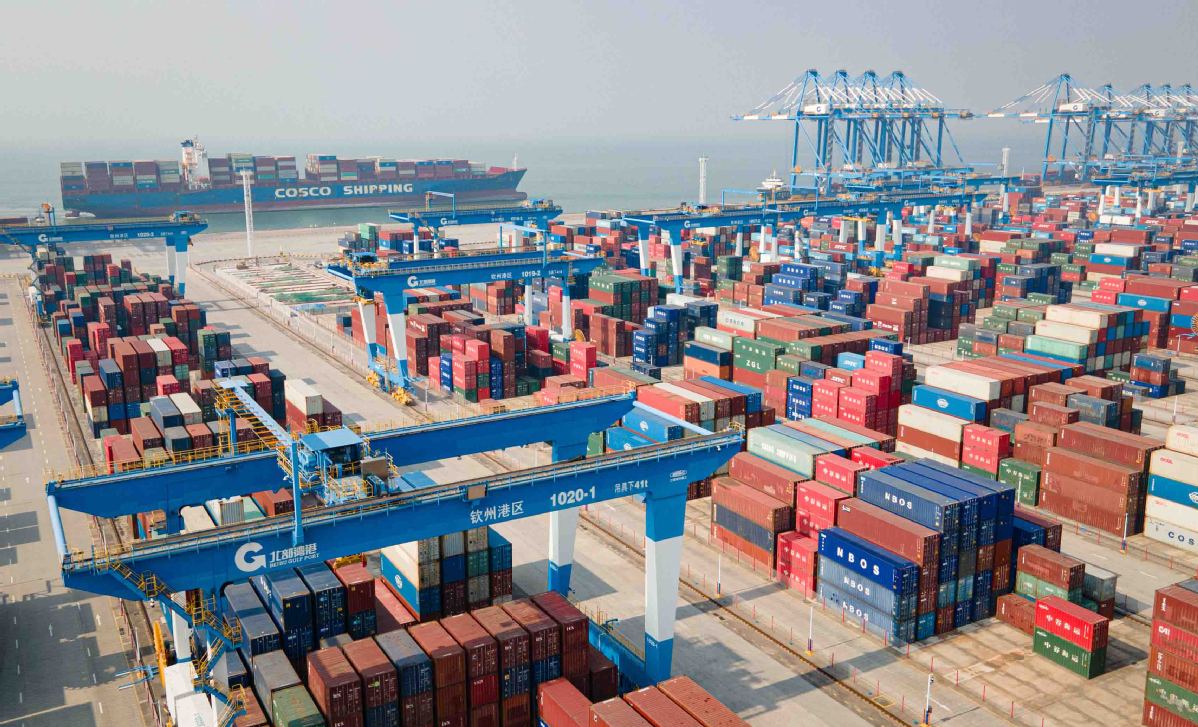Train projects reshape South China regions
Rail network boon for goods transport, job prospects, tourism


Liang Jielin, a tour guide in Rongxian county, Guangxi Zhuang autonomous region, for seven years, said she has never been to the Guangdong-Hong Kong-Macao Greater Bay Area even though it is so near and well known.
Guiding a group of visitors touring Zhenwu Pavilion — an ancient wood-framed facility dubbed "outstanding structure of the South" as a national treasure in Rongxian county, Liang said she is hoping to visit the area after a new high-speed railway traversing her hometown opens in 2027.
State builders are helping construct the new 648-kilometer Nanning-Zhuhai HSR, which runs for 304 km in Guangxi and 344 km in neighboring Guangdong province, with a designed speed of 350 km per hour for the trains, cutting the travel time on an existing HSR from 3.5 hours to 2.5 hours.
The railway connects Nanning, Yulin, Cenxi, the Pearl River Delta hub airport, Jiangmen, Zhuhai and Shenzhen. The current route to Shenzhen has to transit from Guangzhou — the provincial capital — and only allows trains to run 250 km/h.
Yang Jin, a tourist from Shenzhen, was visiting Zhenwu Pavilion under the prefecture-level city of Yulin with 44 others in a tour group. He said they spent nearly four hours on the current HSR, and after seeing the pavilion, they hoped to visit Yuntian Palace — a massive structure incorporating traditional Chinese culture with modern architectural styles — in the city proper of Yulin.
Yang said both Guangxi and Guangdong have plenty of natural resources and rich sightseeing spots. The new railway can boost two-way passenger flow, especially on weekends.
Wang Wei, a staff member from Fifth Engineering Co Ltd of China Railway No 4 Engineering Group, which is building two bids on the Yulin-Cenxi section, said he is proud of taking part in constructing the new Nanning-Zhuhai HSR that will have 18 stations.
"We can view this new railway from a strategic point of view," he said, noting that the new HSR can better link the Guangxi Beibu Gulf Economic Zone with the GBA and is dubbed Guangxi's No 1 infrastructure project to fully integrate into the GBA.
While the Beibu Gulf Economic Zone covers six cities — Nanning, Beihai, Qinzhou, Fangchenggang, Yulin and Chongzuo — in Guangxi, the GBA covers the Hong Kong and Macao special administrative regions, and nine cities in Guangdong: Guangzhou, Shenzhen, Zhuhai, Foshan, Huizhou, Dongguan, Zhongshan, Jiangmen and Zhaoqing.
With the new railway, Guangxi's goods — such as minerals, wooden products, agricultural and sideline products — can quickly reach the 1 trillion yuan ($138.8 billion) strong consumer market in the GBA, Wang said.
Besides the new Nanning-Zhuhai HSR, Guangxi is also building a 237.8-km-long Liuzhou-Wuzhou Railway, also known as the Liuzhou-Wuzhou section of the Liuzhou-Guangzhou Railway, which can transport both goods and passengers and allows trains to run at around 160 km/h upon its expected launch in 2026.
As a major engineering project of the country's 14th Five-Year Plan (2021-25), the railway can also be a main channel for goods from Sichuan, Yunnan and Guizhou provinces and Chongqing municipality to reach the GBA faster, said Hu Feiyu, office director of the CREC4 project department for building the Liuzhou-Wuzhou Railway.
CREC4 is helping build the railway's No 3 bid section with a total length of 27.722 km, worth some 2.176 billion yuan, Hu said.
As for the sugar sector, Guangxi's high-quality white sugar can more quickly enter the food industry cluster in the GBA, and by-products such as molasses can be supplied to biochemical enterprises in the Pearl River Delta region, elevating Guangxi's sugar sector higher up the value chain, Hu added.
























